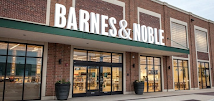Barnes & Noble is flourishing. After a long decline, the company is profitable and growing again—and last week announced plans to open 30 new stores. In some instances, they are taking over locations where Amazon tried (and failed) to operate bookstores.
Amazon seems invincible. So the idea that Barnes & Noble can succeed where its much larger competitor failed is hard to believe. But the turnaround at B&N is real. In many instances they have already re-opened in locations where they previously shut down.
Barnes & Noble is no tech startup, and is about as un-cool as retailers get. It’s like The Gap, but for books. The company was founded in 1886, and it flourished during the 20th century. But the digital age caught the company by surprise.
For a while, Barnes & Noble tried to imitate Amazon. It ramped up online sales, and introduced its own eBook reader (the Nook), but with little success.
Even after its leading bricks-and-mortar competitor Borders shut down in 2011, B&N still couldn’t find a winning strategy. By 2018 the company was in total collapse. Barnes & Noble lost $18 million that year, and fired 1,800 full time employees—in essence shifting almost all store operations to part time staff. Around that same time, the company fired its CEO due to sexual harassment claims.
Every indicator was miserable. Same-store sales were down. Online sales were down. The share price was down more than 80%. (...)
Could anybody fix these problems?
Amazon had taken over the book retailing business, and had already killed Borders. B&N seemed destined to disappear as well. Everything it had done to match up with Amazon had failed, and now it was weaker than ever.
After all its bad moves, Barnes & Noble now was back where it started as a bookstore. But I’ll be blunt about it: B&N was a lousy bookstore. I gave up shopping there because it never had the book I wanted in stock. Instead it shifted a huge portion of its floorspace to peddling toys, greeting cards, calendars, and various chachkas.
The other B&N big initiative was cafes inside the store, but these were even less appealing than the bookstore. I drink a lot of coffee, but I’d need to be desperate for a caffeine fix before I’d buy a cup of java at B&N.
And in a bizarre strategic move, the company decided to launch freestanding restaurants under the name Barnes & Noble Kitchen—no books, just meals. But this was another disaster.
The company chairman Leonard Riggio eventually admitted, in September 2018, that running a restaurant is “a lot harder than you think it is….The bottom line is awful.”
In other words, food at B&N was just like the books, except books don’t stink when they get old. But in this case, everything the brand stood for was looking stale.
The company chairman Leonard Riggio eventually admitted, in September 2018, that running a restaurant is “a lot harder than you think it is….The bottom line is awful.”
In other words, food at B&N was just like the books, except books don’t stink when they get old. But in this case, everything the brand stood for was looking stale.
How Did This Mess Get Fixed?
It’s amazing how much difference a new boss can make.
I’ve seen that firsthand so many times. I now have a rule of thumb: “There is no substitute for good decisions at the top—and no remedy for stupid ones.”
It’s really that simple. When the CEO makes foolish blunders, all the wisdom and hard work of everyone else in the company is insufficient to compensate. You only fix these problems by starting at the top.
In the case of Barnes & Noble, the new boss was named James Daunt. And he had already turned around Waterstones, a struggling book retailing chain in Britain.
Back when he was 26, Daunt had started out running a single bookstore in London—and it was a beautiful store. He had to borrow the money to do it, but he wanted a store that was a showplace for books. And he succeeded despite breaking all the rules.
I’ve seen that firsthand so many times. I now have a rule of thumb: “There is no substitute for good decisions at the top—and no remedy for stupid ones.”
It’s really that simple. When the CEO makes foolish blunders, all the wisdom and hard work of everyone else in the company is insufficient to compensate. You only fix these problems by starting at the top.
In the case of Barnes & Noble, the new boss was named James Daunt. And he had already turned around Waterstones, a struggling book retailing chain in Britain.
Back when he was 26, Daunt had started out running a single bookstore in London—and it was a beautiful store. He had to borrow the money to do it, but he wanted a store that was a showplace for books. And he succeeded despite breaking all the rules.
by Ted Gioia, The Honest Broker | Read more:
Image: uncredited
